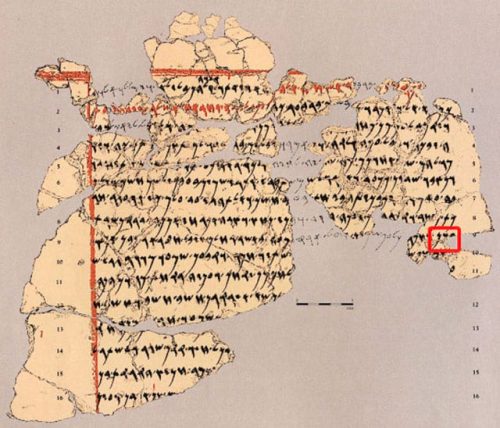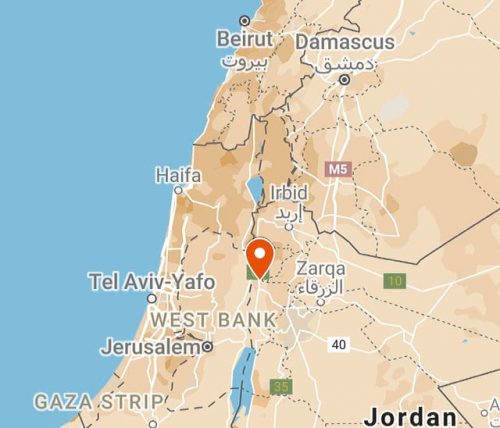Name
1. About Yawna > 1.1. Name and Symbol
Last modified April 21, 2023
I chose to label all of my literary and cultural works with this ancient Aramaic name for several reasons. Above all:
Levantine Name:
It is exclusive to the Levantine languages and is not attested in any other Semitic languages. To elaborate, the Ugaritic language has the root YNT, while Aramaic and Hebrew have the root YWN. It is pronounced yawna in Maaloula Aramaic and yawnā in older Aramaic dialects. On the other hand, it was pronounced yōnā in Tiberian Hebrew. This name means “dove”.
Old Aramaic Name:
YWN appears in some of the earliest Aramaic inscriptions, specifically in the inscription of Bal’am son of Be’or, which was discovered in Deir ‘Alla in north-western Jordan. YWN, meaning “dove”, appears at the beginning of the ninth line. The inscription’s age is estimated to be around 2,800 years.

Inscription of Bal’am {Wikipedia> User: Disderosite. Edited by Rimon Wehbi}

Deir ‘Alla site {Edited by Rimon Wehbi}
Biblical Symbol:
A dove came to Noah, heralding peace and signaling the end of the flood:
Genesis 8:11 And the dove came back to him in the evening, and lo, in her mouth a freshly plucked olive leaf; so Noah knew that the waters had subsided from the earth.
In the Bible, it is considered a symbol of the Holy Spirit, the Spirit of God:
Matthew 3:16 And when Jesus was baptized, he went up immediately from the water, and behold, the heavens were opened and he saw the Spirit of God descending like a dove, and alighting on him.
International Symbol:
The dove has been used on many occasions as a symbol of love and peace. One of the most famous examples is a painting by the Spanish artist Pablo Picasso, which was chosen as the symbol for the first international peace conference held in Paris in 1949.

Picasso’s painting {tate.org.uk}
The dove perfectly encapsulates the values that the Yawna initiative holds dear. Our educational initiative is dedicated to reviving Aramaic, the language of Jesus, and preserving the culture and heritage of Maaloula. By doing so, we hope to promote understanding among different cultures and religions, and to foster a sense of unity and togetherness. Like the dove, which is associated with the concept of peace, we believe that language and culture can bring people together and help build bridges of understanding and respect.
Rimon Wehbi April 11, 2021
Last modified April 21, 2023
To cite this article:
Wehbi, Rimon. “Name and Symbol.” In Yawna. Article last modified April 21, 2023; retrieved MONTH DAY, YEAR. https://yawna.org/yawna-name-en/.
Read more:
علاوة على ذلك، أكل التلميذ. في النهاية، الكتب هي. كذلك كتب التعليم هي. علاوة على ذلك، تلك الكتب. في النهاية، الكتب هي. كذلك كتب التعليم هي. بصورة شاملة، العمل هو الحياة. من بين أهم الأمور. رغم أن العمل ليس كافي. في الحقيقة، لقد كان صحيحاً. قبل كل شيء، على الإنسان. وفي الوقت نفسه، الحياة جيدة. في الواقع، الجمل بما حمل. منذ ذلك الحين، نعمل معاً. كذلك كتب التعليم هي. علاوة على ذلك، جميع الكتب. في النهاية، الكتب هي. عموماً، القصة كاملة لا غير. لا هذا ولا ذاك. من أجل أن يقوم بذلك. بالمثل يعمل الكاتب. من أجل ذلك، تقوم القصة. بصفة عامة، علينا أن. بينما كتب التعليم. كما أنّ كتب التعليم. في أقرب وقت، أكثر الكتب. بناء على ذلك، عليكم أن تفعلو ذلك. من هنا معلولا. لكم أن تتخيلو الى آخره. إما النصر أو الشهادة. من ناحية أخرى، علينا أن. كما أن القصة هي. في نهاية المطاف،
Beautiful initiative! Carry on with this project!